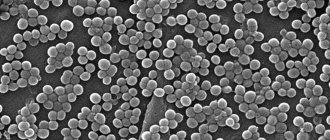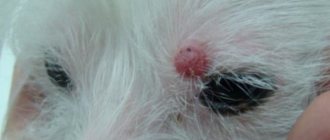Causes of poisoning
Rat poison itself has a distinct unpleasant odor.
But manufacturers of rodent poison give it a tempting meaty aroma that can attract not only rats and mice, but also dogs. The dog can eat the poison itself, or a rodent that has previously been poisoned by it. In both cases, the poison enters the dog's body and is absorbed into the bloodstream through the gastric mucosa.
Rat poison can be specially laid out to kill dogs; not only homeless people, but also pets suffer from this.
How does rat poison affect a dog's body?
If a dog has eaten poison or a poisoned rodent, severe pathological changes begin to occur in its body. Most poisons that are produced to kill rats affect all systems of the animal's body, and lead to painful death.
Below are the main components that can be found in rat poison, and the features of their effect on the dog’s body are discussed:
- Rodenticides (anticoagulants) – these substances, when entering the animal’s body, affect blood clotting. They contribute to the development of massive internal bleeding and can cause hemorrhagic stroke.
- Rat poison is one of the most dangerous poisons for the dog’s body. It leads to damage to the central nervous system, the development of pulmonary edema, and acute heart failure.
- Zinc phosphide – affects the digestive and nervous systems.
Please note that a very small amount of toxic substance (several mg) is required for a dog to be poisoned.
Main clinical signs of rat poison poisoning in dogs
When poisoned by rat poison, symptoms may appear within the first few hours in dogs. The exception is rodenticides. When consuming them, the first clinical signs may appear after a few days.
Remember that puppies are more sensitive to mouse poison and their symptoms develop much faster. The lethal dose of poison for a puppy is less than for an adult dog.
If a dog has eaten a poisoned mouse, the onset of symptoms may take a little longer.
The table below shows the main symptoms of rat poison poisoning depending on the active substance:
| Name of the poison | Main symptoms |
| Rodenticides |
|
| Krysid |
|
| Zinc phosphide |
|
Mechanism of action of poisons
Poisoning with any rat poison is dangerous because the effects of the poison on the body begin immediately, and the first symptoms appear after about two days. The absence of signs of intoxication in the first hours after taking the poison is due to the presence of vitamin K in the body, which inhibits the effect of the toxin.
When dogs are poisoned with rat poison, the substances of the 1st and 2nd generation rodenticides penetrate into the gastrointestinal tract, and then into the blood. As a result, the synthesis of proteins responsible for blood clotting occurs. When intoxicated with 1st generation rodenticides, the synthesis of vitamin K is disrupted and the blood stops clotting. The principle of action of 2nd generation rodenticides is the same, however, due to the specific structure, it is more difficult for substances to be removed from the body.
When zinc phosphide enters the stomach, poisonous phosphine gas is formed. The greater the amount of food the dog consumed before taking the poison, the more phosphine there will be. The gas provokes acute flatulence, damage to the liver and nervous system.
In case of poisoning with rodenticides, for treatment it is necessary to resume the synthesis of vitamin K, the deficiency of which provokes unpleasant symptoms. To do this, phytomenathodine is injected subcutaneously into the animal. In the Russian Federation, vitamin K (“Phytomenadione”) is officially certified, so it is impossible to obtain it legally. Veterinarians use vitamin K3 instead. However, this is not effective enough: K3 has a positive effect only in combination with other means.
To treat rat poisoning, a dog needs to consume tannin, and when zinc phosphide is consumed, a solution of soda or copper sulfate in the required dosage. In particularly severe cases of poisoning, the animal is given a blood transfusion.
First generation rodenticides are eliminated from the animal’s body fairly quickly after successful treatment. When using 2nd generation rodenticides, the recovery process will be much longer. Ratsid is especially toxic, and the rehabilitation process after such poisoning is the longest.
After removing the poison from the dog’s body, the veterinarian prescribes symptomatic treatment depending on the consequences of the poison on the body (the degree of damage to the liver, kidneys, and nervous system). For this purpose, antibiotics, iron, and heart medications may be prescribed.
First aid
If your pet has ingested mouse poison, it should be treated at a veterinary clinic. When the first symptoms of intoxication appear, the animal should be taken to a veterinarian. If for some reason you cannot do this right away (you are outside the city, there is no 24-hour veterinary hospital nearby), start helping him yourself. Your actions will help the dog live to see the vet.
Please note that giving your dog strong medications without a veterinarian's prescription is dangerous. The dosage for an animal is different from that for humans. Also, you will not know what chemical reaction the poison and the drug will enter into.
First aid for dog poisoning consists of the following:
Diet
When the first signs of poisoning appear, remove the bowl of food from the dog. The digestive system needs rest. You can start eating after your veterinarian's permission.
Gastric lavage
Rinse your dog's stomach. To do this you will need a 20 ml syringe. Squirt water into the animal's mouth and press on the root of the tongue to induce vomiting. Pour 20 ml of water into puppies and small dogs, 40 ml for medium-sized dogs, and 60-80 ml for large dogs. Do not add any medicines, herbal infusions or potassium permanganate to the water. Plain water at room temperature is suitable for gastric lavage.
Remember that potassium permanganate, even in a small concentration, can cause burns and intoxication of the mucous membrane of the esophagus and stomach in an animal. Now this substance is prohibited, but many still have it in their home medicine cabinet.
Colon cleansing
Perform colonic lavage with an enema. For rinsing, take a children's enema bulb with a volume of 50-100 ml. Fill the enema with plain water at room temperature and insert it into your dog's rectum. Then, wait until she goes to the toilet and repeat this procedure several more times.
When performing an enema on dogs, a problem may arise - an animal that is used to relieving itself on the street will restrain itself after the enema and ask to go for a walk. In this case, you will have to take out, or take (if there is severe weakness) the dog out into the yard.
Sorbents
Sorbents are substances that bind and remove poisons and toxins from the body.
Give the dog a sorbent to drink. Everyone has Activated Charcoal in their first aid kit. Calculate its dosage for an animal in the same way as for a person: 1 tablet per ten kg of weight. For example, if his weight is 5 kg, you will need half a tablet, and if he weighs 50 kg, 5 tablets. Don’t be afraid to exceed the amount a little; it’s better to let your pet drink a little more sorbent rather than less. For example, if the animal weighs 17 kg, give it 2 tablets.
Getting your dog to swallow a pill is not easy. It is best to grind the required amount of Activated Carbon and dilute it in 10-15 ml of water. Inject this solution into her mouth through a syringe. If she spits out the medicine, try again.
If you have a veterinary sorbent at home and you know the rules for dosing it, you can use it.
Drink plenty of fluids
It is necessary to give your dog water to replenish water losses that occurred during vomiting and diarrhea, and to relieve intoxication in the body.
The animal should be given regular non-carbonated water. The dog needs to pour 10 ml of water into its mouth every 10 minutes (if the dog is very tiny - 5 ml).
Please note that if your dog is poisoned by rodenticides, rinsing the stomach and intestines is prohibited. This may increase internal bleeding. Put the dog on a fast, give it something to drink and sorbents.
First aid kit
Experts have developed a special list of medications that should be in the home of every dog owner. Such items and medications will make the owner of a 4-legged friend fully prepared to provide first aid in case of poisoning. This list included:
- 3% peroxide solution;
- a set of syringes of different sizes, which are intended for washing the eyes;
- a rubber bulb necessary for cleaning the mouth;
- several packages of activated carbon;
- thermometer;
- numbers of veterinarians, emergency services for 4-legged animals.
What does treatment at a veterinary hospital consist of?
The veterinarian will first examine the animal and measure its vital signs (pulse, blood pressure, oxygen saturation, body temperature).
The owners should tell the doctor about what happened to the dog: when it happened, what symptoms appeared first, what first aid was given to the dog. In case of rodenticide poisoning, their antidote, vitamin K, is administered . In all other cases, treatment is symptomatic and aimed at removing the poison from the body, replenishing water and electrolyte losses, and treating complications from internal organs. It may consist of the following groups of drugs:
- sorbents;
- saline laxatives;
- enzymes;
- painkillers;
- anti-inflammatory;
- corticosteroids;
- heart medications;
- diuretics;
- solutions for intravenous rehydration;
- antibiotics.
If your animal is in serious condition, it will be kept in the hospital for several days. If the dog is feeling stable, the doctor will explain to you what to do and tell you when to come to him for injections, IVs and examination.
First aid for a dog in case of poisoning
The animal can be saved. According to statistics, after eating such a poisoned element, the outcome is quite favorable. At first, immediately after getting hit, it is necessary to provide first aid as soon as possible. It includes:
- calling the gag reflex;
- washing the gastric tract with a weak solution of potassium permanganate;
- adsorbent therapy (give the animal Polysorb, Enterosorb);
- laxative treatment (saline laxatives are often given).
Animal examination
To identify complications from internal organs and systems, the veterinarian may prescribe a number of laboratory and instrumental examinations:
- A general blood test will help identify hemolysis of red blood cells and anemia.
- A general urine test is necessary to diagnose kidney damage.
- A biochemical blood test is performed to determine the performance of the pancreas, liver and kidneys.
- Ultrasound examination (ultrasound) of internal organs can help identify acute damage.
- ECG, echocardiography is indicated for the development of heart failure.
- X-ray of the head - if a hemorrhagic stroke is suspected.
The veterinary clinic may not have sufficient equipment to perform these tests, and you will be sent to another veterinary hospital to complete the diagnosis.
Prevention of poisoning
Rat poisoning in dogs often results in death. It is much easier to avoid contact of your pet with this poison. Below are tips to help with this:
- Walk your dog on a leash and muzzle. This way you will be sure that your pet will not pick up anything from the ground.
- From an early age, teach your dog that eating anything from the ground is prohibited.
- If deratization (destruction of rodents) is planned in the premises where you live, take the dog to another home for a while (to relatives, friends, or board at a veterinary clinic).
- In the village, prohibit your dog from running around barns, cellars, and chicken coops. There she can find a dead, poisoned mouse.
Poisoning with rat poison in dogs leads to severe damage to the internal organs of the animal and, in the absence of medical care, to death. When the first signs of poisoning develop, take your pet to a veterinary clinic. There he will be given first aid, examined and treated.
First aid for various symptoms
Statistics say that if first aid was provided immediately or the dog was shown to the veterinarian immediately, the animal recovers in 85% of cases. Every owner must understand the seriousness of the situation and not delay the process of providing first aid for poisoning in dogs.
The first thing that needs to be noted is that it is mandatory to contact a veterinarian in case of any suspicion. If the owner notices at least some symptoms of a dog being poisoned by rat poison, he should immediately contact a specialist, having first provided first aid to the animal.
If a dog has been poisoned by rat poison based on zinc phosphide, the room in which the animal is waiting for the veterinarian should be well ventilated, because phosphine is very toxic to the human body. Despite the logic of offering food to an animal, it is strictly prohibited to do this until you receive appropriate instructions from a veterinarian.
To provide full first aid if rat poisoning occurs in dogs, the following measures must be taken:
- rinse the stomach (perform with a syringe with warm, but not hot water);
- induce vomiting (effective only in the first two hours after consuming the poison);
- give an enema;
- give sorbents;
- organize plenty of drinking.











